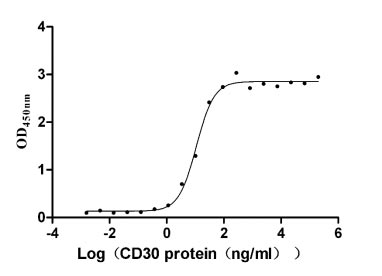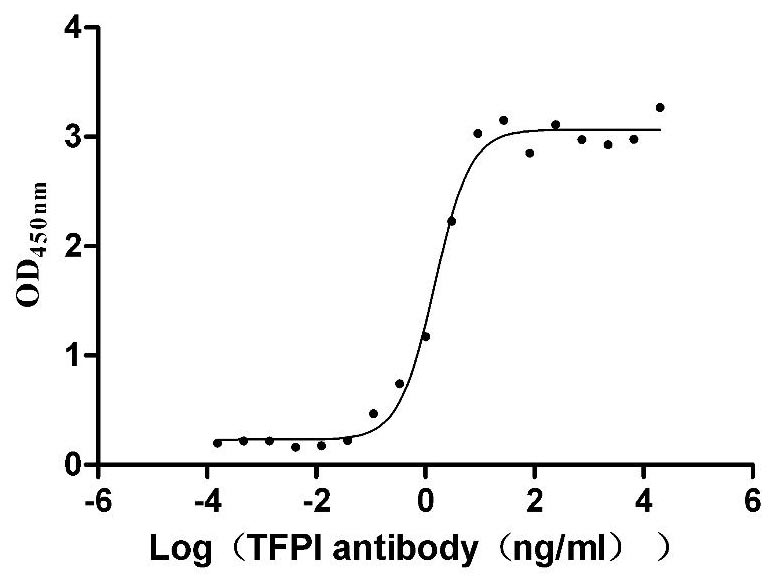Recombinant Mouse Prothrombin (F2)
-
货号:CSB-YP007923MO
-
规格:
-
来源:Yeast
-
其他:
-
货号:CSB-EP007923MO
-
规格:
-
来源:E.coli
-
其他:
-
货号:CSB-EP007923MO-B
-
规格:
-
来源:E.coli
-
共轭:Avi-tag Biotinylated
E. coli biotin ligase (BirA) is highly specific in covalently attaching biotin to the 15 amino acid AviTag peptide. This recombinant protein was biotinylated in vivo by AviTag-BirA technology, which method is BriA catalyzes amide linkage between the biotin and the specific lysine of the AviTag.
-
其他:
-
货号:CSB-BP007923MO
-
规格:
-
来源:Baculovirus
-
其他:
-
货号:CSB-MP007923MO
-
规格:
-
来源:Mammalian cell
-
其他:
产品详情
-
纯度:>85% (SDS-PAGE)
-
基因名:
-
Uniprot No.:
-
别名:F2; Cf2; Prothrombin; EC 3.4.21.5; Coagulation factor II) [Cleaved into: Activation peptide fragment 1; Activation peptide fragment 2; Thrombin light chain; Thrombin heavy chain]
-
种属:Mus musculus (Mouse)
-
蛋白长度:Full Length of Mature Protein
-
表达区域:44-618
-
氨基酸序列ANSGFLE ELRKGNLERE CVEEQCSYEE AFEALESPQD TDVFWAKYTV CDSVRKPRET FMDCLEGRCA MDLGVNYLGT VNVTHTGIQC QLWRSRYPHK PEINSTTHPG ADLKENFCRN PDSSTTGPWC YTTDPTVRRE ECSVPVCGQE GRTTVVMTPR SGGSKDNLSP PLGQCLTERG RLYQGNLAVT TLGSPCLPWN SLPAKTLSKY QDFDPEVKLV ENFCRNPDWD EEGAWCYVAG QPGDFEYCNL NYCEEAVGEE NYDVDESIAG RTTDAEFHTF FNEKTFGLGE ADCGLRPLFE KKSLKDTTEK ELLDSYIDGR IVEGWDAEKG IAPWQVMLFR KSPQELLCGA SLISDRWVLT AAHCILYPPW DKNFTENDLL VRIGKHSRTR YERNVEKISM LEKIYVHPRY NWRENLDRDI ALLKLKKPVP FSDYIHPVCL PDKQTVTSLL RAGYKGRVTG WGNLRETWTT NINEIQPSVL QVVNLPIVER PVCKASTRIR ITDNMFCAGF KVNDTKRGDA CEGDSGGPFV MKSPFNNRWY QMGIVSWGEG CDRKGKYGFY THVFRLKRWI QKVIDQFG
-
蛋白标签:Tag type will be determined during the manufacturing process.
The tag type will be determined during production process. If you have specified tag type, please tell us and we will develop the specified tag preferentially. -
产品提供形式:Lyophilized powder
Note: We will preferentially ship the format that we have in stock, however, if you have any special requirement for the format, please remark your requirement when placing the order, we will prepare according to your demand. -
复溶:We recommend that this vial be briefly centrifuged prior to opening to bring the contents to the bottom. Please reconstitute protein in deionized sterile water to a concentration of 0.1-1.0 mg/mL.We recommend to add 5-50% of glycerol (final concentration) and aliquot for long-term storage at -20℃/-80℃. Our default final concentration of glycerol is 50%. Customers could use it as reference.
-
储存条件:Store at -20°C/-80°C upon receipt, aliquoting is necessary for mutiple use. Avoid repeated freeze-thaw cycles.
-
保质期:The shelf life is related to many factors, storage state, buffer ingredients, storage temperature and the stability of the protein itself.
Generally, the shelf life of liquid form is 6 months at -20°C/-80°C. The shelf life of lyophilized form is 12 months at -20°C/-80°C. -
货期:Delivery time may differ from different purchasing way or location, please kindly consult your local distributors for specific delivery time.Note: All of our proteins are default shipped with normal blue ice packs, if you request to ship with dry ice, please communicate with us in advance and extra fees will be charged.
-
注意事项:Repeated freezing and thawing is not recommended. Store working aliquots at 4°C for up to one week.
-
Datasheet :Please contact us to get it.
靶点详情
-
功能:Thrombin, which cleaves bonds after Arg and Lys, converts fibrinogen to fibrin and activates factors V, VII, VIII, XIII, and, in complex with thrombomodulin, protein C. Functions in blood homeostasis, inflammation and wound healing.
-
基因功能参考文献:
- These results suggested that the thrombinstimulated synthesis of IL6 was limited by HSP90 in osteoblasts, and that the effects of HSP90 were exerted at the point between Rhokinase and p38 MAPK. PMID: 30066835
- Platelet derived microparticles formed in sepsis are a potent inducer of thrombin generation via phosphatidylserine exposure, and activation of both the intrinsic and extrinsic pathway of coagulation. PMID: 28409836
- These findings imply that a thrombin-pericyte interaction in the brain could be a significant mechanism responsible for blood-brain barrier dysfunction under obesity-associated diabetic conditions and thus could represent a therapeutic target for central nervous system complications of diabetes. PMID: 28489922
- mutations were introduced into the endogenous fII gene, resulting in expression of prothrombin carrying 3 amino acid substitutions (R157A, R268A, and K281A) to limit activation events to yield only fIIa(Meizothrombin) Homozygous fII(MZ) mice are viable, express fII levels comparable with fII(Wild type) mice, and have reproductive success. PMID: 27252233
- allosteric inhibitor SbO4L targets the glycoprotein Ibalpha-binding and heparin-binding site of thrombin PMID: 26748875
- thrombin/PAR-1 interaction regulated MCP-1, TF, MCSF and IL-6 production. PMID: 26475502
- Observations illustrate the role of thrombin as a pleiotropic atherogenic molecule under conditions of hypercholesterolemia and suggest the utility of its inhibition with locally acting antithrombin nanoparticle therapeutics. PMID: 26769047
- Thrombin-PAR1 signaling, via nitric oxide and EPCR, promotes hematopoietic stem cell (HSC) mobilization. PMID: 26457757
- Primary tumor growth by colon cancer cells was reduced by reduction of circulating prothrombin. There were lower mitotic indices and invasiveness. This growth relied upon 2 targets of thrombin-mediated proteolysis, protease: PAR-1 and fibrinogen. PMID: 26238780
- Thrombin promotes sustained signaling and inflammatory gene expression through the CDC25 and Ras-associating domains of phospholipase C epsilon. PMID: 26350460
- thrombin/PAR1 pathway as a novel target for developing therapeutic strategies to restore synaptic function in the acute phase of ischemic stroke. PMID: 25604482
- High Factor IIa expression is associated with multiorgan pathologies in sickle cell disease. PMID: 26286849
- Blockage of thrombin exosites with compounds specific for exosite I (hirudin and HD1 aptamer) or exosite II (heparin and HD22 aptamer) impaired the COMP-thrombin interaction, indicating a 2-site binding mechanism. PMID: 26045608
- Fyn, but not Lyn, was required for complete Pyk2 phosphorylation by thrombin. PMID: 25967238
- Thrombin cleavage of osteopontin disrupts a pro-chemotactic sequence for dendritic cells, which is compensated by the release of its pro-chemotactic C-terminal fragment. PMID: 25112870
- The Ras-related protein, Rap1A, mediates thrombin-stimulated, integrin-dependent glioblastoma cell proliferation and tumor growth. PMID: 24790104
- Influenza virus H1N1 activates platelets through FcgammaRIIA signaling and thrombin generation. PMID: 24665136
- These results indicate that thrombin acts through multiple mechanisms to activate MMPs and PGE2 synthesis in amnion. PMID: 24652285
- Suggest a thrombin-dependent mechanism of complement activation by red blood cell-microvesicles independent of the classical, lectin, or alternative pathway. PMID: 24311376
- thrombin induces monocyte/macrophage migration via PAR1-Galpha12-dependent Pyk2-mediated Gab1 and p115 RhoGEF interactions, leading to Rac1- and RhoA-targeted Pak2 activation. PMID: 24025335
- Micro-computed tomography analysis of distal tibia metaphyses also revealed for the first time a major impact of the FVIII/thrombin/PAR1 axis on the dynamic bone structure. PMID: 23982175
- PKCalpha and Akt modulate platelet function by phosphorylating and inhibiting GSK3alpha/beta, thereby relieving the negative effect of GSK3alpha/beta on thrombin-mediated platelet activation. PMID: 23239877
- Mast cell restricted mouse and human tryptase.heparin complexes hinder thrombin-induced coagulation of plasma and the generation of fibrin by proteolytically destroying fibrinogen. PMID: 22235124
- Recombinant thrombomodulin domains 2 and 3 protein significantly reduces atherosclerosis and neointima formation through its thrombin-binding ability. PMID: 21840881
- Protective roles for fibrin, tissue factor, plasminogen activator inhibitor-1, and thrombin activatable fibrinolysis inhibitor, but not factor XI, during defense against the gram-negative bacterium Yersinia enterocolitica. PMID: 21724997
- Active site-labeled prothrombin inhibits prothrombinase in vitro and thrombosis in vivo PMID: 21531712
- The development of inflammatory joint disease is attenuated in mice expressing the anticoagulant prothrombin mutant W215A/E217A. PMID: 21436072
- Localization and expression of prothrombin in rodent osteoclasts and long bones. PMID: 21191574
- platelet STIM1 and Orai1 have roles in glycoprotein VI- and thrombin-dependent procoagulant activity and thrombus formation PMID: 20519511
- Hirudin preconditioning of vWF-deficient mice attenuated processing of infused rpvWF suggesting that thrombin plays a part in the processing events in vivo. PMID: 11776313
- effect of hirudin treatment indicates endogenous thrombin contributes to tumor implantation, seeding, and spontaneous metastasis PMID: 15265791
- mouse thrombin lacks Na+ activation but retains high catalytic activity PMID: 16428384
- beta(3) integrin, thrombin, and Ca(2+) play critical roles in platelet aggregation without fibrinogen or VWF PMID: 16824188
- Thrombin and MMP-9 collaborate to promote neuronal death in culture and in intracerebral hemorrhage (ICH). PMID: 17021183
- findings indicate thrombin plays a major role in extraintestinal thrombus formation associated with experimental colitis PMID: 18772359
- thrombin-induced p65/RelA, AMPK, and PKCdelta activation were markedly reduced by knockdown of the TRPC isoform TRPC1 expressed in human endothelial cells and in endothelial cells obtained from Trpc4 knock-out mice. PMID: 18990707
- formation of thrombin through the procoagulant activity of FVIII is necessary to induce costimulation for the immune response to FVIII treatment PMID: 19794141
显示更多
收起更多
-
蛋白家族:Peptidase S1 family
-
数据库链接:
KEGG: mmu:14061
STRING: 10090.ENSMUSP00000028681
UniGene: Mm.89048
Most popular with customers
-
Recombinant Human Tumor necrosis factor ligand superfamily member 8 (TNFSF8), partial (Active)
Express system: Mammalian cell
Species: Homo sapiens (Human)
-
Recombinant Human HLA class II histocompatibility antigen gamma chain (CD74), partial (Active)
Express system: Mammalian cell
Species: Homo sapiens (Human)
-
Recombinant Human Tissue factor pathway inhibitor (TFPI), partial (Active)
Express system: Mammalian cell
Species: Homo sapiens (Human)
-
Recombinant Human Carcinoembryonic antigen-related cell adhesion molecule 8(CEACAM8) (Active)
Express system: Mammalian cell
Species: Homo sapiens (Human)
-
Recombinant Human Interleukin-1 receptor accessory protein (IL1RAP), partial (Active)
Express system: Mammalian cell
Species: Homo sapiens (Human)



-AC1.jpg)













